In the dynamic world of professional football, the allure of titles and financial prospects often dominates players’ decision-making when choosing their next club. However, an intangible force can wield equal, if not more, influence: the persuasive power of a revered coach. Bayer 04 Leverkusen, a club known for its steady performances but lacking the charisma of some Bundesliga giants, has harnessed this power to its advantage. With limited financial resources, they have managed to make a splash in the transfer market by relying on the reputation and influence of their new head coach, Xabi Alonso.
Xabi Alonso, the Spanish star coach, has instantly captured the attention of potential recruits, making Bayer Leverkusen an enticing destination for many sought-after players. His illustrious playing career and footballing knowledge have garnered immense respect within the footballing community, and his appointment as the head coach has injected newfound charisma into the factory club.
With several prominent additions citing Xabi Alonso as a critical factor in their decision to join Bayer Leverkusen, the club is embarking on a promising new era. As the Spanish tactician enters his first full season, there is a palpable sense of optimism surrounding the team’s prospects. The objective is clear: to secure a coveted spot in the premier class of European football.
This tactical analysis will delve into the transformational impact of Xabi Alonso‘s presence at Bayer Leverkusen in the form of a scout report. His excellent reputation opens doors that may have otherwise remained closed to the club. By looking at Bayer Leverkusen’s transfer strategy and the type of players drawn to the club in this analysis, we will understand the tactics Xabi Alonso brings to the team. His footballing philosophy and coaching methods are expected to mould Bayer Leverkusen into a competitive force capable of challenging the Bundesliga’s traditional powerhouses.
Initial Position
The 2022/23 season was a rollercoaster ride for Bayer 04 Leverkusen, characterised by both struggles and glimpses of promise. The campaign kicked off with great difficulties, as the team faced several setbacks under former coach Gerardo Seoane. After a disappointing exit in the first round of the DFB-Pokal against SV Elversberg and seven defeats in the first 11 Bundesliga and UEFA Champions League games, Seoane was relieved of his duties, leaving the club languishing in 17th place on the Bundesliga table.
Enter Xabi Alonso, the Spaniard tasked with turning Leverkusen’s fortunes around. Taking over an unsettled side, Alonso faced the daunting task of reinvigorating the team’s performance and instilling a winning mentality. With an emphasis on attacking play and improved defensive organisation, Alonso began to reshape the team’s identity and style of play.
Under Alonso’s guidance, Bayer Leverkusen’s attacking prowess shone through, culminating in the sixth-highest goal tally in the league with 57 goals scored throughout the season. With an average of 1.56 goals per 90 minutes, Leverkusen outperformed their own expected goals (xG) value of 53.86, showcasing their clinical finishing and effectiveness in front of goal.
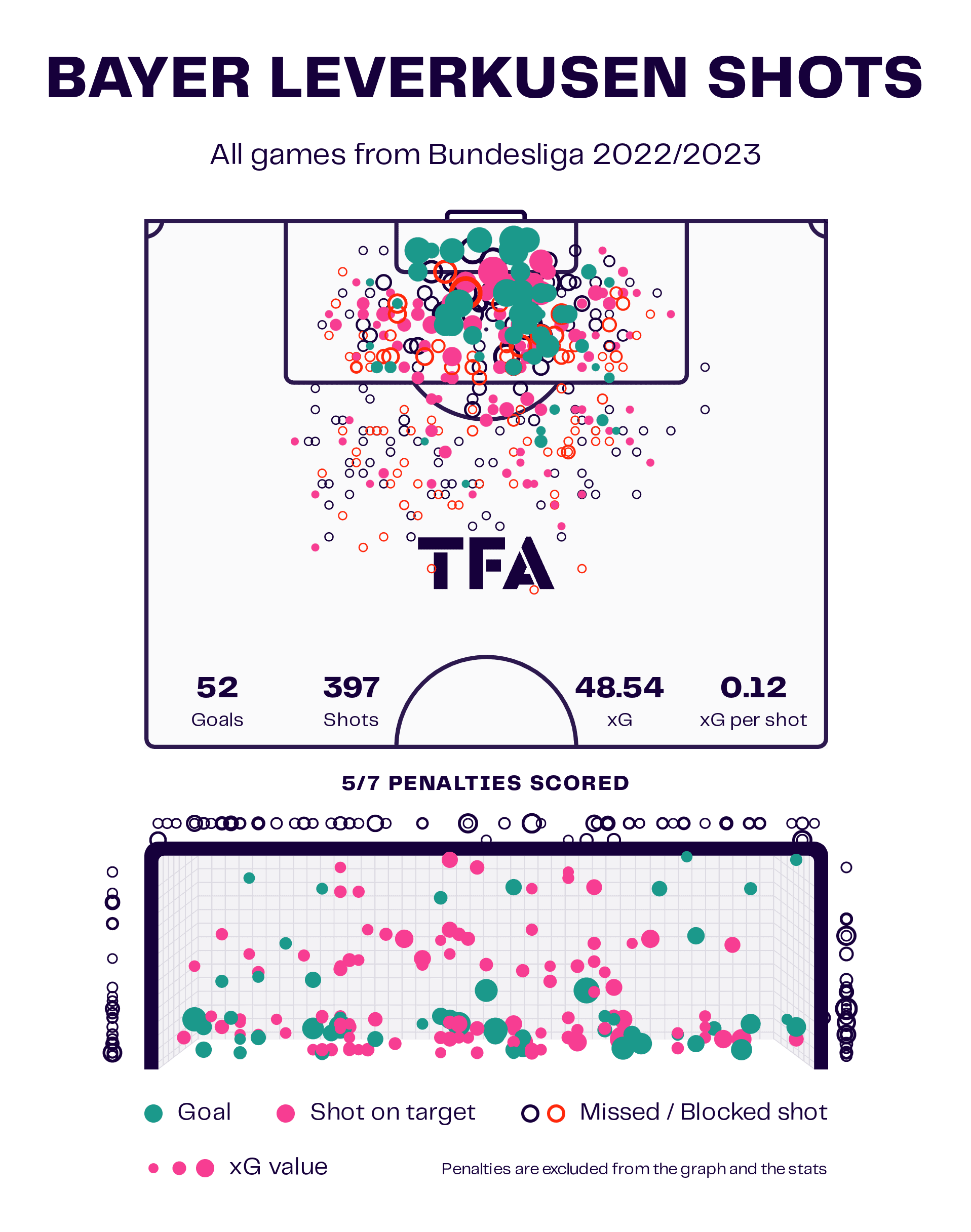
The defensive improvements under Alonso were evident, with Leverkusen conceding the seventh-fewest goals in the Bundesliga (49), equivalent to 1.34 goals per 90 minutes. However, it should be noted that they still conceded more goals than their expected goals conceded (xG conceded: 46.09), indicating room for further defensive development.
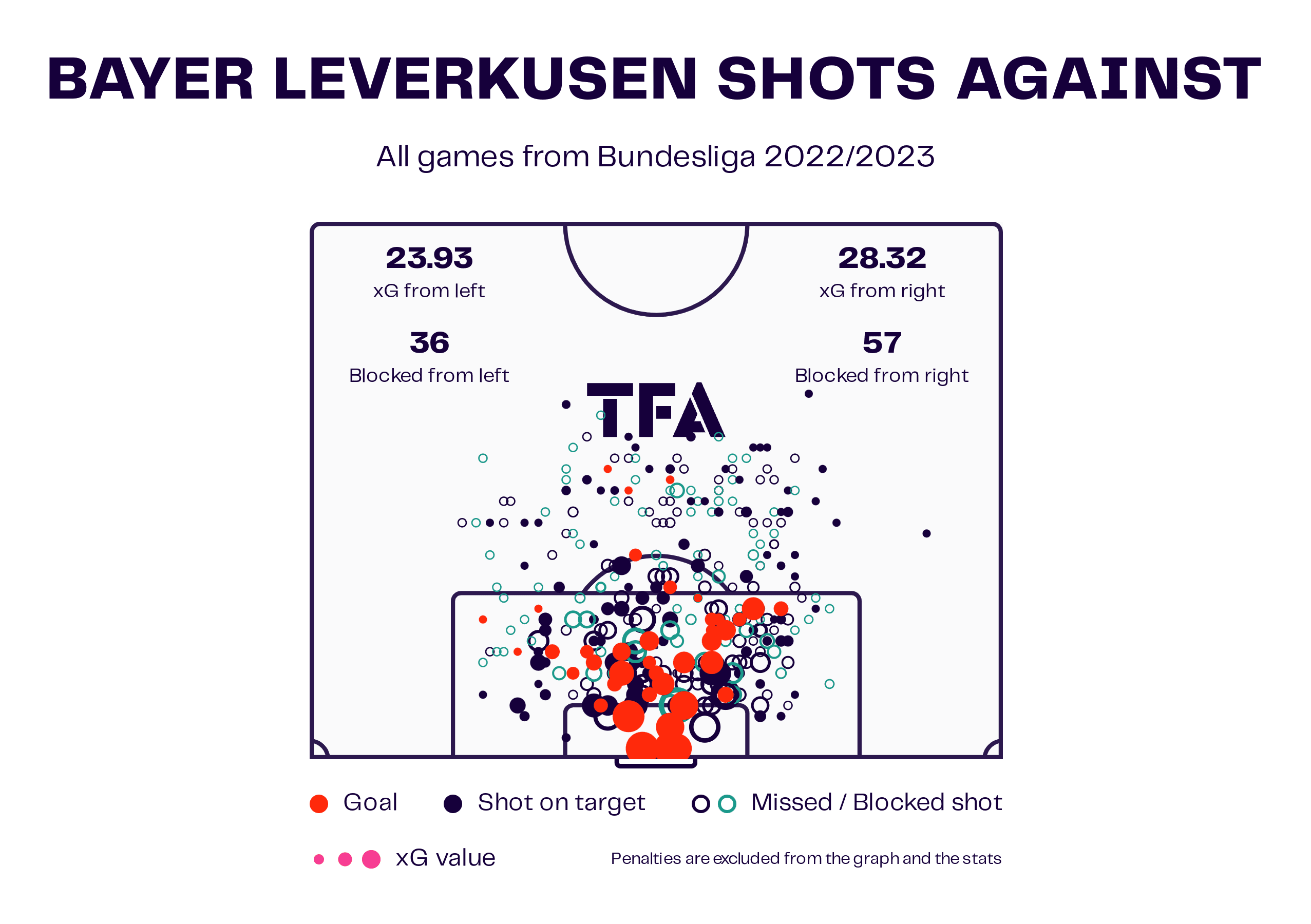
Goalkeeper Lukas Hradecky came under scrutiny throughout the season. While there were questions surrounding his performances, Alonso continued to place trust in his abilities to help bolster the team’s defensive stability.
One of the highlights of Leverkusen’s season was the emergence of an extremely young and talented squad, which showcased its strengths in attacking play. With Alonso nurturing their abilities, the team displayed glimpses of its potential to compete at the highest level.
Leverkusen’s performances improved significantly as the season progressed under Alonso’s guidance. By the end of the campaign, the team managed to secure a commendable sixth-place finish in the Bundesliga table, earning a direct qualification spot for the Europa League. Although the team’s talent suggests they could contend for Champions League qualification, Alonso’s tenure was just beginning, and there are hopes for further progress and success in the seasons to come.
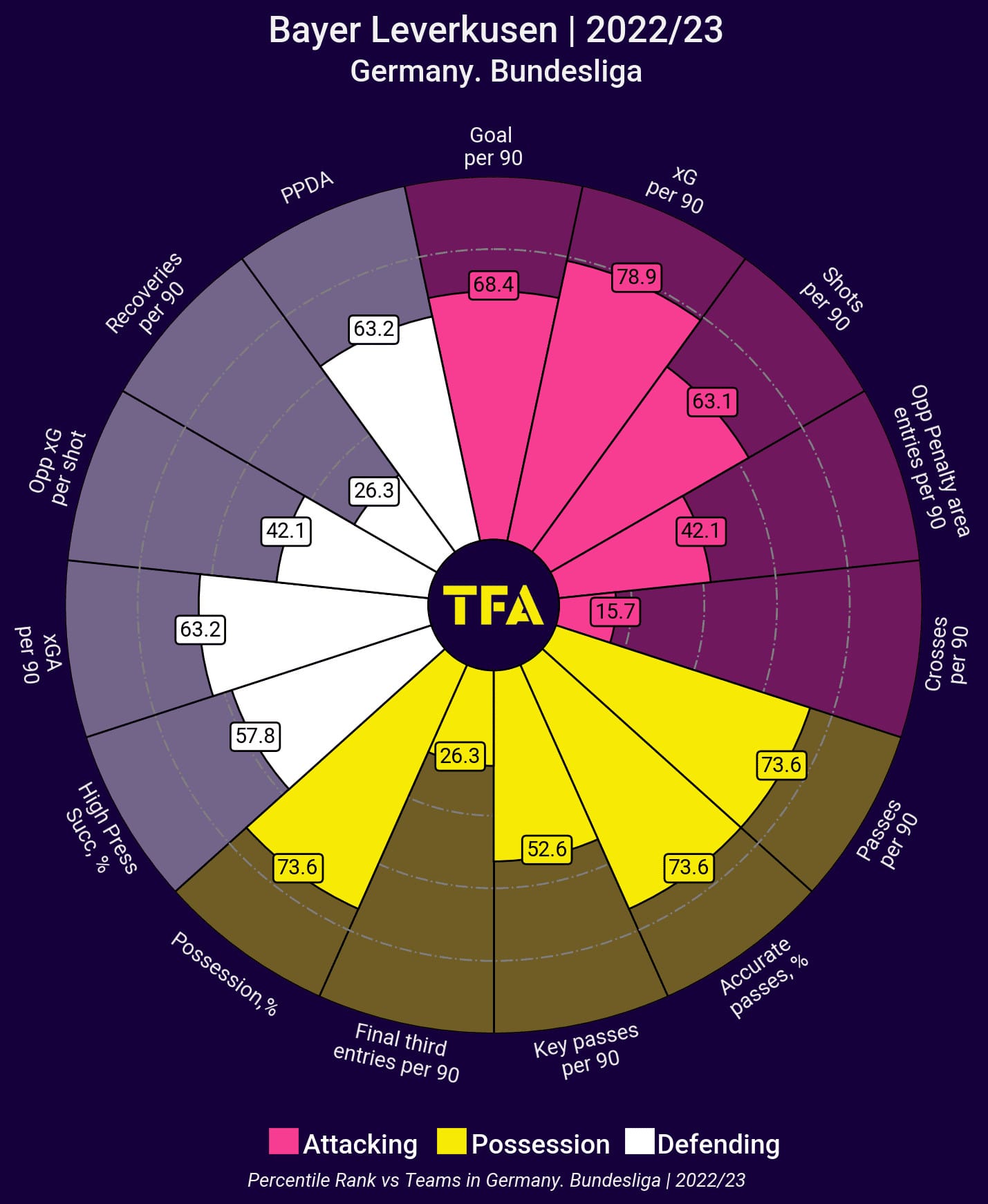
As Bayer Leverkusen prepares for the new season, there is a sense of anticipation and optimism surrounding the impact that Xabi Alonso will continue to have on the squad. With time and further development, the team’s youthful core and attacking prowess could propel them to even greater heights in domestic and European competitions. The stage is set for Bayer Leverkusen to rise under the guidance of their esteemed Spanish coach.
Alonso’s Tactics
Since taking charge at Bayer Leverkusen, Xabi Alonso has shown a clear preference for a 3-4-3 (or 3-4-2-1) formation, which he believes provides the ideal balance of compactness and dynamism. Many managers experiment with various shapes to find the right fit for their team. Still, Alonso has placed his faith in this setup due to its effectiveness in different game phases.
Alonso has opted for a more balanced defensive approach to address former issues in the defensive phase using the 5-2-3 or 5-4-1 formation. By strengthening the flanks with defensively strong players, he ensures his team is not caught with too many players out of position. The focus is on tactical awareness and intelligent positioning to bolster the team’s central areas, reducing vulnerabilities in their defensive structure.
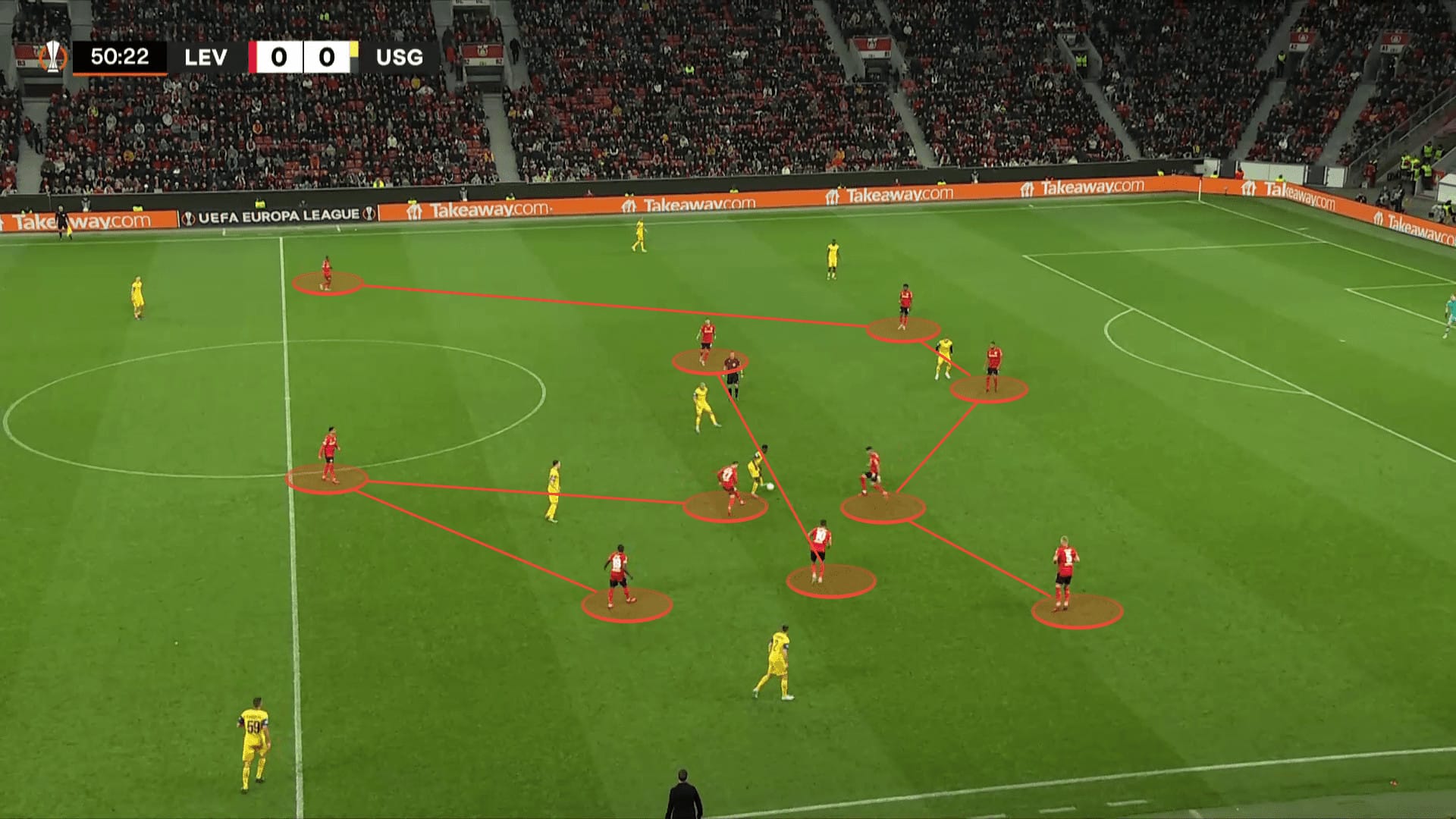
Transitions have become a crucial aspect of Bayer Leverkusen’s game under Alonso’s guidance. Unlike many sides that retreat into a 5-4-1 when not in possession, Leverkusen’s front three stays narrow, compressing the midfield and forcing opponents wide. Their backline spreads across the width of the pitch, allowing them to apply pressure in distant areas from their goal. As a result, they excel at winning the ball back and quickly transitioning from defence to attack, capitalising on vulnerable opponents.
Counterattacks are an essential feature of Alonso’s approach. When Leverkusen lose the ball, they immediately begin pressing, making their 3-4-3 configuration highly effective in these situations. Their quick attacking plays have contributed significantly to creating scoring opportunities and taking shots on goal.
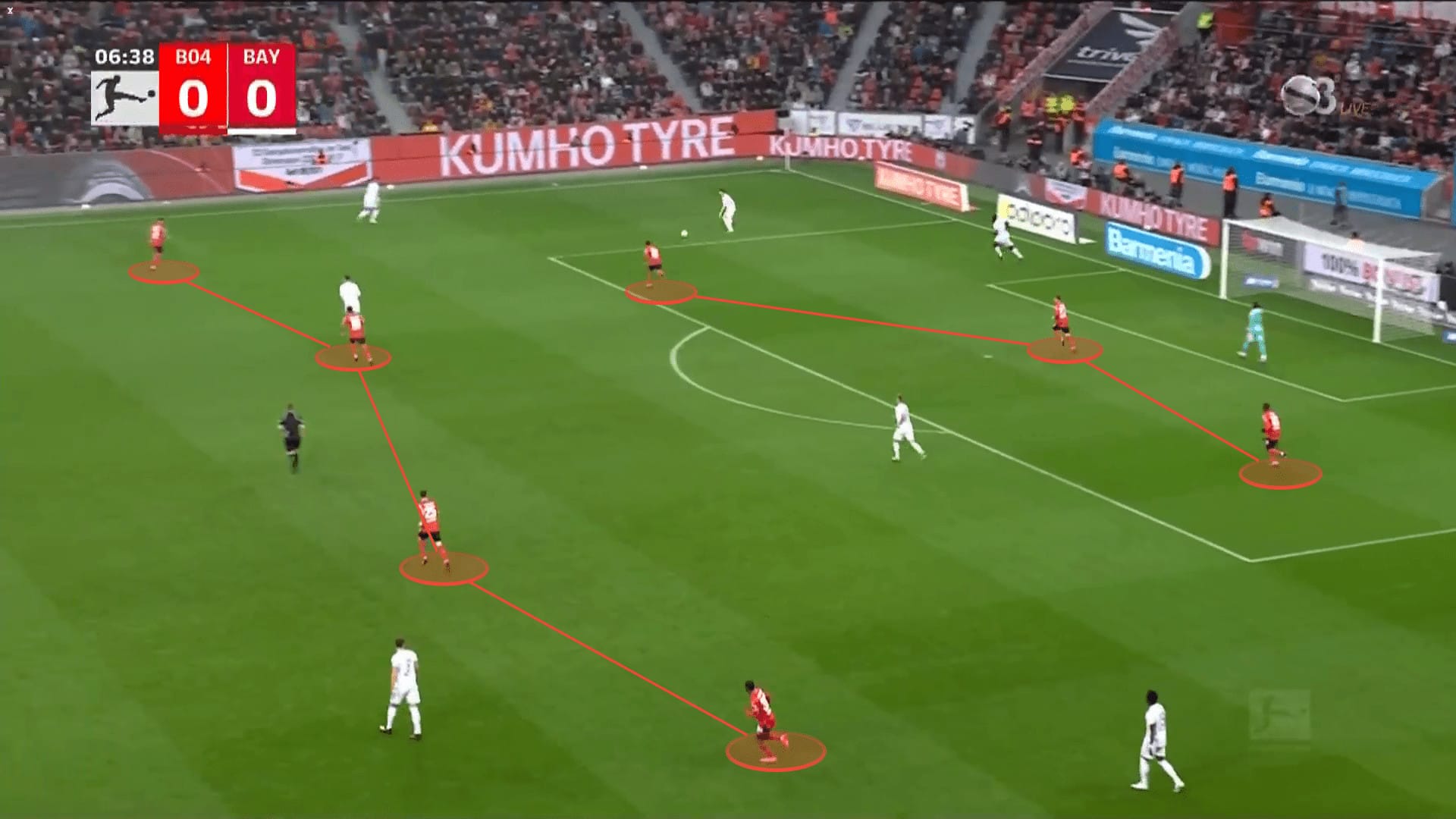
In the attacking phase, positional attacks are emphasised, especially during a mid-block. The behaviour of the pivots plays a vital role in the team’s effectiveness. With Alonso’s experience playing in such a position, he understands the qualities required to execute this strategy successfully.
As they build from the back, Leverkusen’s back three often transform into a back two, with a central defender moving into the defensive midfield zone. The wing-backs’ positioning close to the sidelines provides passing options, granting the team the width and compactness needed for effective build-up play.
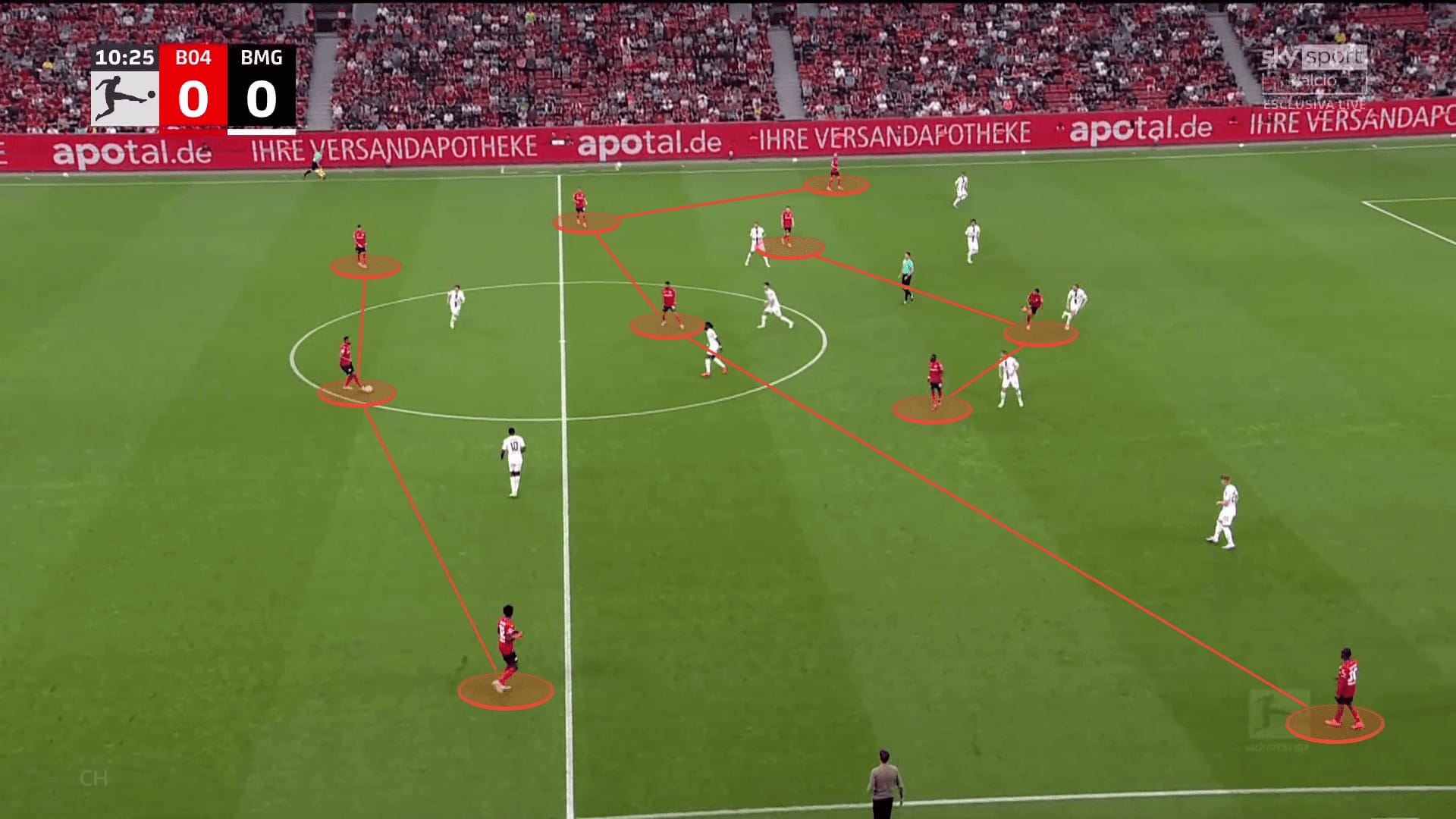
Transfers
As the transfer window unfolds, Bayer Leverkusen have been actively reshaping its squad, making strategic moves to ensure a competitive and promising team for the upcoming Bundesliga season. Notable departures have included goalkeepers Andrey Lunev and Lennart Grill, as well as Ayman Azhil, Karim Bellarabi, Daley Sinkgraven, Mitchell Bakker, and wingers Paulinho and Moussa Diaby. Among the current players, the future of crucial asset Jeremie Frimpong remains uncertain as other clubs express interest in his services.
However, Leverkusen’s transfer activity showcases a savvy and calculated approach despite the departures and potential exits. The club has focused on securing promising new talents and top-quality players to reinforce their ranks. The signings demonstrate Leverkusen’s ambition to remain a top team in the Bundesliga and compete at the highest level in domestic and international competitions.
One of the club’s exciting additions is right-back Arthur, an up-and-coming talent from Brazil’s América-MG. His arrival bolsters the team’s defensive options and adds youthful potential to the squad. Additionally, Ayman Aourir, a product of Leverkusen’s youth system, brings the team a blend of familiarity and new potential.
Leverkusen’s ambition for success is further evident in acquiring three top players at the international level. Victor Boniface, Jonas Hofmann, Granit Xhaka, and Alejandro Grimaldo are notable signings, each bringing their skills and experience to the club. Hofmann’s versatility, Xhaka’s commanding presence in midfield, and Grimaldo’s attacking prowess as a left-back offer significant improvements to Leverkusen’s overall squad depth.
Bayer Leverkusen have made a significant addition to their squad in the summer transfer window, securing the services of Jonas Hofmann from Bundesliga competitor Borussia Mönchengladbach. The German international brings valuable Bundesliga experience, having also previously played for Borussia Dortmund, making him a valuable asset for his new club.
Hofmann’s versatility is one of his key attributes, providing Bayer Leverkusen with multiple tactical options. While he is typically deployed on the right wing, he can adapt and contribute effectively in various positions across the midfield. His natural inclination, however, is to orient himself centrally, where he excels in shaping the game and influencing proceedings from a central role.
Possession of the ball is undoubtedly Hofmann’s greatest strength. His exceptional vision and technique make him a standout performer in the final third. His ability to execute precise short passes, incisive through balls, and well-timed passes allow him to dictate the flow of the game and create scoring opportunities for his teammates.
Hofmann’s preference for seeking vertical solutions aligns perfectly with Bayer Leverkusen’s direct playing style, particularly in quick counterattacks orchestrated by coach Xabi Alonso. Another of Hofmann’s most significant assets is his goalscoring threat.
Under Alonso’s guidance, Hofmann is expected to flourish, as the Spanish coach’s tactics complement his playing style. Leverkusen’s direct approach on the counter, combined with Hofmann’s creativity and goal threat, presents an exciting prospect for the team’s attacking potential in the upcoming season.
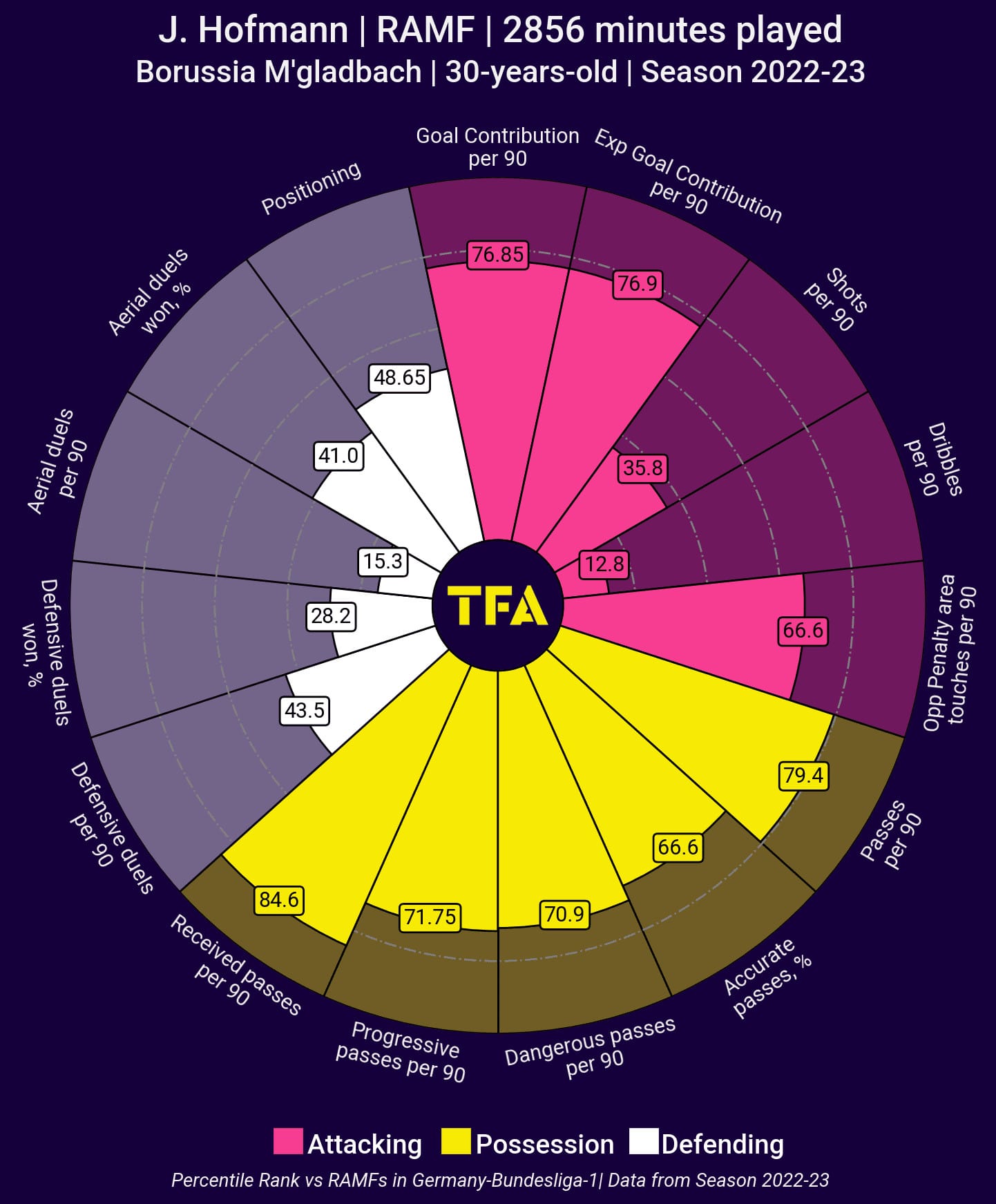
Bayer Leverkusen have secured another major signing in the summer transfer window with the acquisition of Granit Xhaka. The Swiss international returns to the Bundesliga with significant experience, having previously played for Borussia Mönchengladbach before showcasing his skills in the English Premier League with Arsenal FC.
Xhaka’s playing style perfectly aligns with the profile of a box-to-box midfielder. He possesses a relentless work rate and is actively involved in pressing actions in the opposition’s half, making him an invaluable asset in Leverkusen’s midfield setup. His tenacity and ability to disrupt opponents’ build-up play provide the team with defensive solidity and a foundation for initiating quick attacking moves.
In possession, Xhaka showcases his passing prowess as a critical component of his playmaking abilities. At the same time, he doesn’t frequently engage in dribbling; his vision and precise passing open up opportunities for creating chances and orchestrating the team’s attacks. As a midfielder who excels in transitioning the ball from defence to attack, Xhaka’s passing abilities complement Bayer Leverkusen’s direct and counterattacking style under coach Xabi Alonso.
Defensively, Xhaka exhibits moderate involvement in recoveries and pressing in high areas. His tactical discipline and positional awareness allow him to disrupt the opposition’s attacking patterns and regain possession for his team. His defensive contributions offer Leverkusen an added layer of stability, especially in high-pressure situations.
Having honed his skills at top clubs both in the Bundesliga and the Premier League, Xhaka brings a wealth of experience and leadership to Bayer Leverkusen’s midfield. His physical presence and tireless work ethic make him a key asset in both the defensive and offensive phases of play.
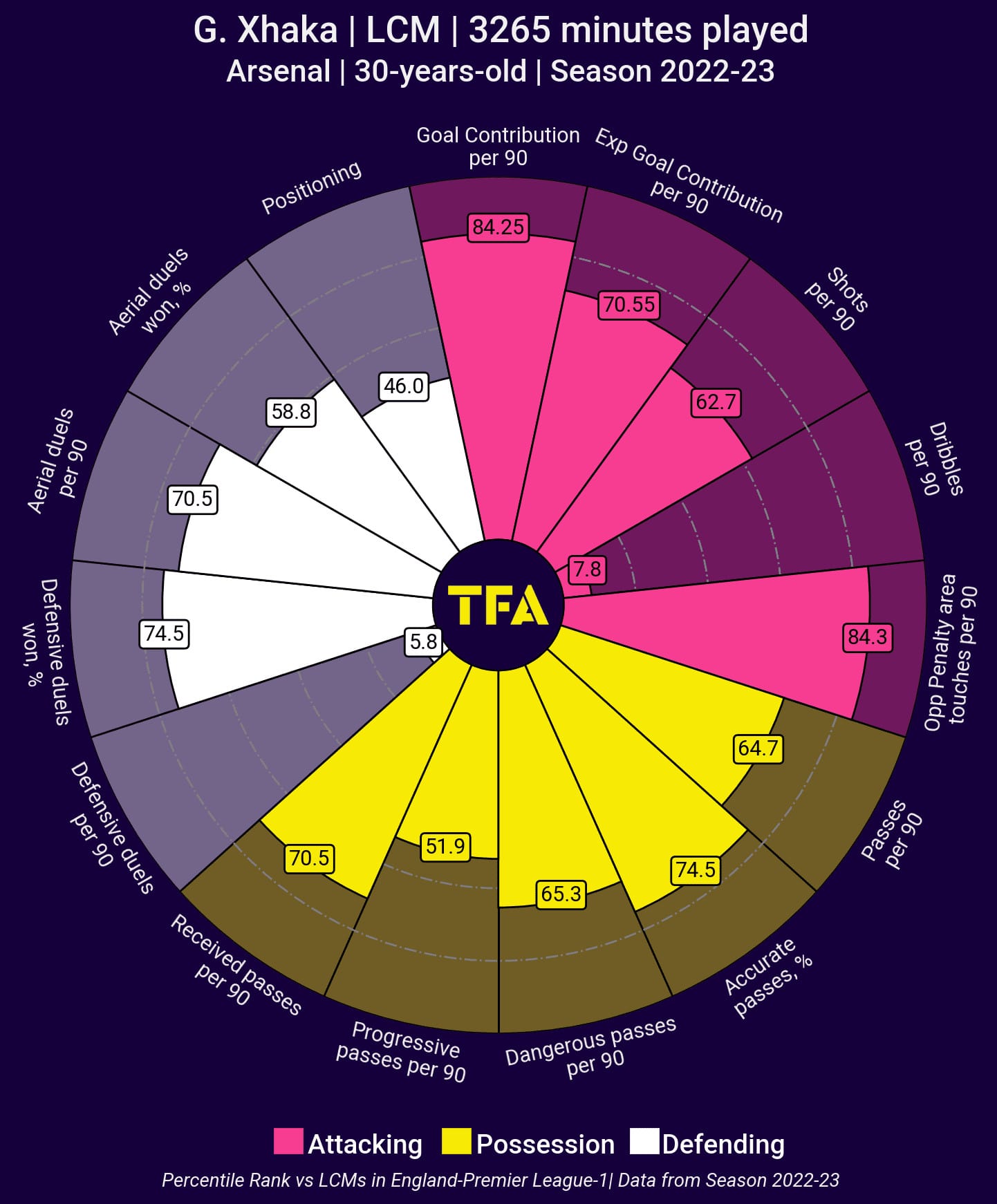
Bayer Leverkusen have made a third significant addition to their squad in the summer transfer window with the acquisition of Alejandro Grimaldo from Benfica. The 27-year-old Spaniard arrives at Leverkusen with a wealth of experience, having spent several fruitful years at Benfica after leaving FC Barcelona’s renowned La Masia youth academy.
Grimaldo’s playing style perfectly complements Leverkusen’s attacking mindset under coach Xabi Alonso. He brings a unique dimension to the team’s offensive capabilities as an inverted wing-back. His primary involvement lies in attacking actions, where he actively contributes with numerous dribbles, precise crosses, and a high shot output. Grimaldo’s penchant for taking on defenders and his ability to deliver dangerous balls into the box make him a potent weapon in Leverkusen’s attacking arsenal.
Coming from Barcelona’s esteemed La Masia academy, Grimaldo brings tactical knowledge and technical skills that have been honed at one of the world’s most renowned youth development centres. His understanding of the game and ability to read situations on the pitch make him an intelligent and astute player, adding an extra layer of quality to Leverkusen’s squad.
The Spaniard’s arrival will undoubtedly bolster Leverkusen’s attacking options from the wing-back position. His inclination to combine with the midfielders and forwards in central areas suits Xabi Alonso’s direct and fluid playing style. Grimaldo’s ability to contribute significantly to the team’s attacking play makes him a valuable asset in Leverkusen’s quest for domestic and European success.
Leverkusen’s ambitions for the new season are evident as the team continues to strengthen its squad with top-quality signings. With the addition of Alejandro Grimaldo, the club enhances its attacking prowess from the wing-back position, providing Xabi Alonso with a versatile and dynamic player capable of influencing matches in multiple ways.
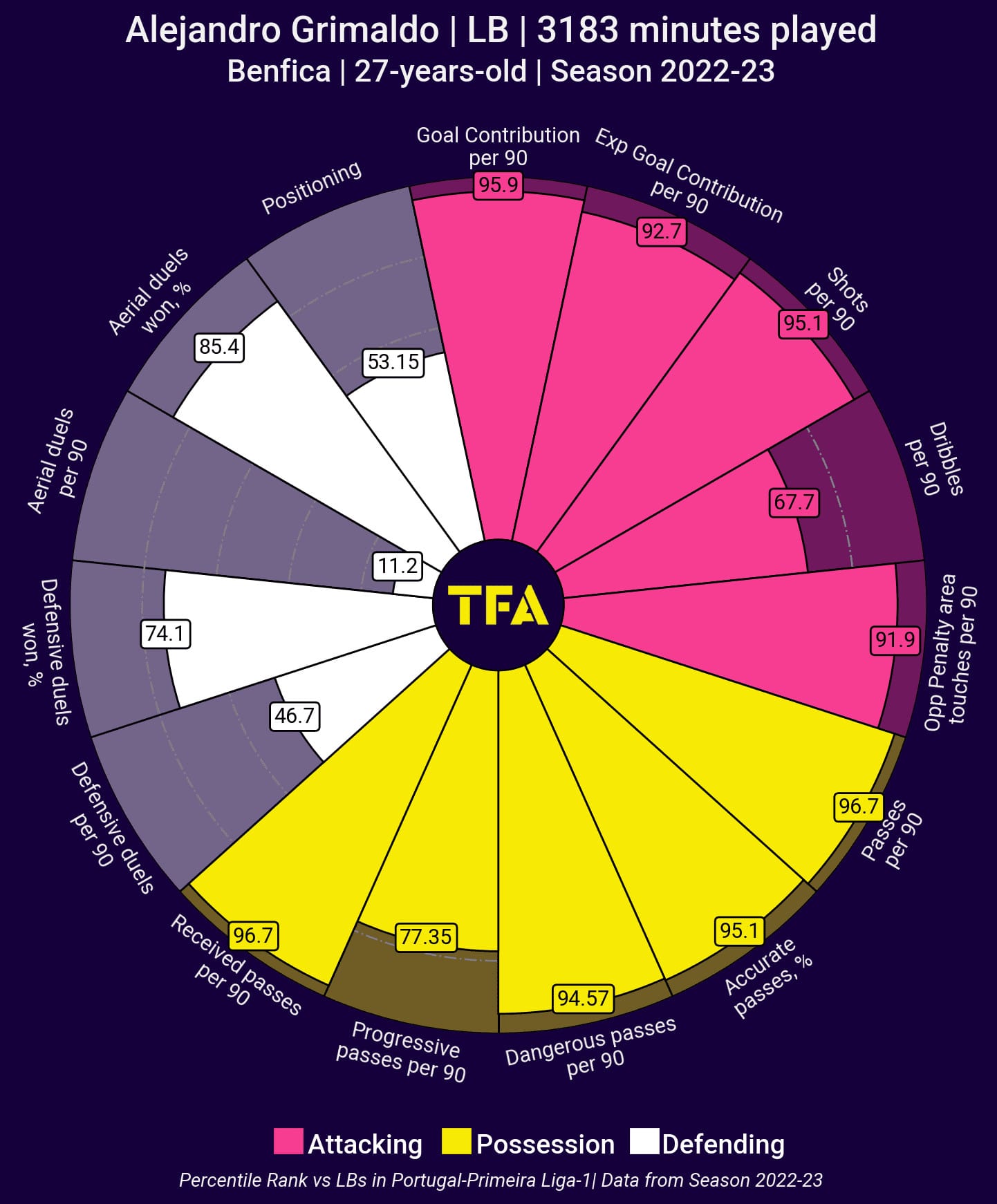
With their intelligent and calculated approach in the transfer market, Bayer Leverkusen are positioning themselves to remain a formidable force in German football. Their focus on securing promising talents and experienced stars demonstrates a balanced, forward-thinking transfer philosophy.
Potential Line-up
Heading into the 2023/24 season, Bayer Leverkusen boasts a formidable and exciting line-up in a dynamic 3-4-3 formation. The team’s strengths lie in its blend of youthful exuberance and experienced talent, making them a force to be reckoned with in both domestic and European competitions.
In goal, the dependable Lukas Hradecky, with his wealth of experience, provides a steady presence between the posts. In front of him, the youthful trio of Piero Hincapie, Edmond Tapsoba, and Odilon Kossounou form a formidable and athletic centre-back trio capable of handling any offensive threat.
The wing-back positions are filled with attacking prowess and tactical versatility. On the left, Alejandro Grimaldo showcases his attacking prowess as an inverted wing-back, combining his defensive acumen with incisive runs and dangerous deliveries. On the right, the rapid and skilful Jeremie Frimpong provides width and explosive pace, creating havoc for opposition defences.
In central midfield, the combination of Granit Xhaka and Florian Wirtz offers a perfect balance of defensive solidity, passing ability, and creativity. Xhaka’s tenacity and tactical awareness provide the foundation for Leverkusen’s defensive stability, while Wirtz’s vision and passing range enable him to orchestrate attacks from deep.
The attacking midfield positions boast the creative flair and goal threat necessary to unlock opposition defences. Amine Adli’s technical ability, pace and dribbling skills make him a constant threat down the flanks. Jonas Hofmann’s versatility and goal-scoring prowess from midfield add a potent dimension to Leverkusen’s attack.
Upfront, there might be a new top scorer in Bundesliga with Victor Boniface. His ability to link up play and deep runs makes him a nightmare for opposing defenders. With a keen eye for goal, Boniface’s intelligent movement and clinical finishing can make him a pivotal figure in Leverkusen’s attacking endeavours.
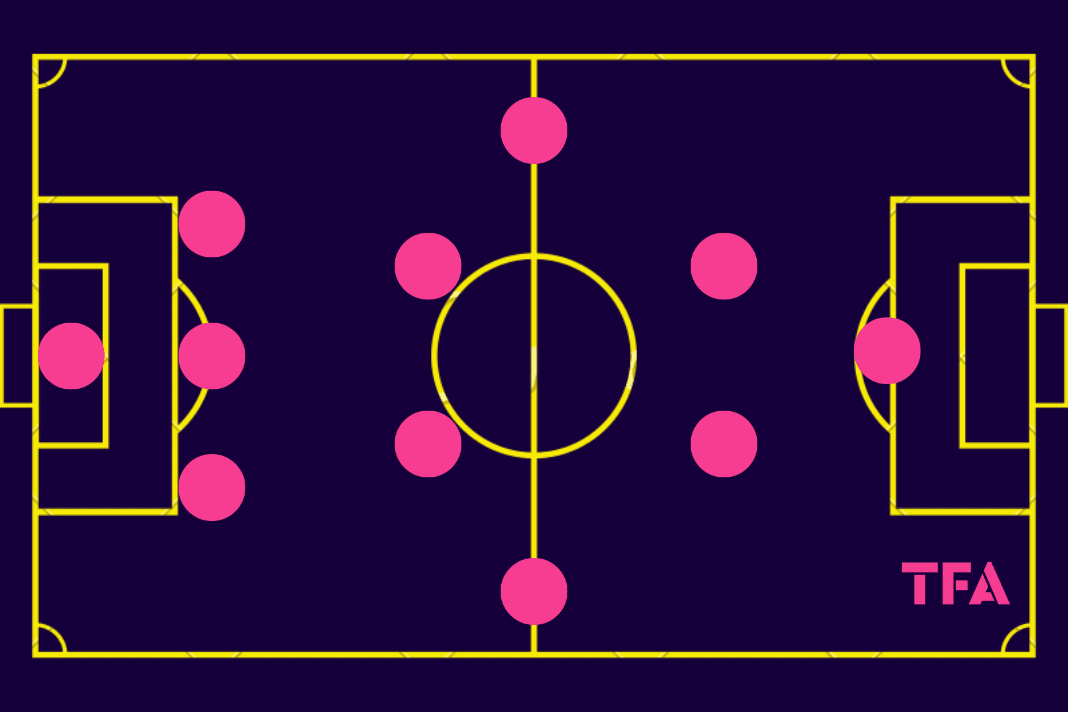
Leverkusen’s 3-4-3 formation, under the astute management of coach Xabi Alonso, allows for fluid and dynamic play in defence and attack. The team’s tactical flexibility and balance between youth and experience provide a potent blend of talent, positioning them as strong contenders in the Bundesliga and beyond.
Conclusion
Xabi Alonso’s tactical brilliance at Bayer Leverkusen has shown its potential to create a well-rounded and effective team. With a focus on compactness, dynamic transitions, and positional attacks, the Spanish coach’s approach has elevated Leverkusen’s performances and positioned them for further success in the future. As Alonso continues to fine-tune his tactics and work with a talented squad, Bayer Leverkusen’s prospects in both domestic and European competitions look increasingly promising.
Leverkusen’s fans can look forward to an exciting and competitive team as they embark on the new season, with high hopes for domestic and international success. As the squad gels and under the guidance of their coaching staff, Bayer Leverkusen are poised for another strong campaign and aims to achieve their ambitions for silverware in the Bundesliga and beyond.





Comments